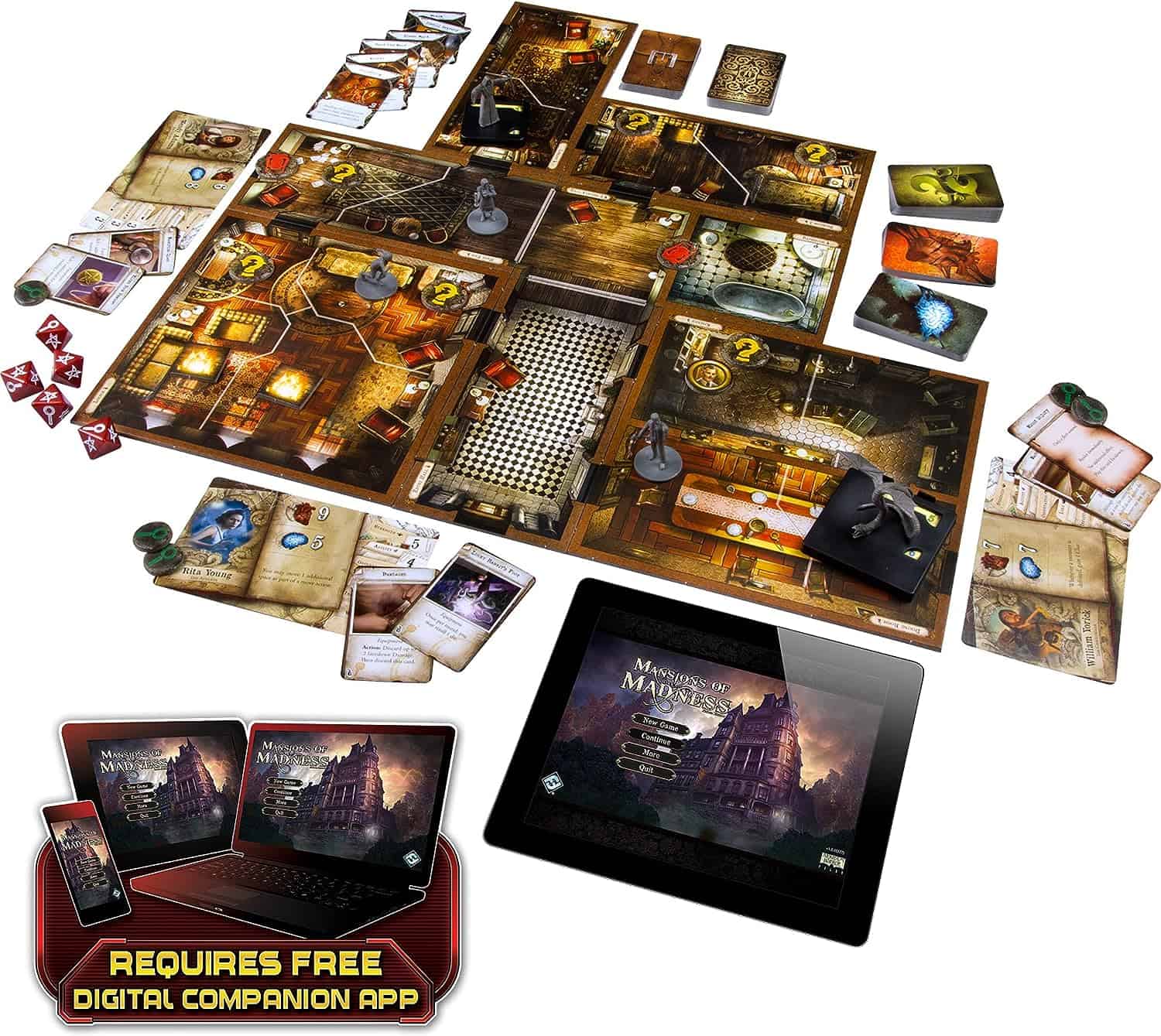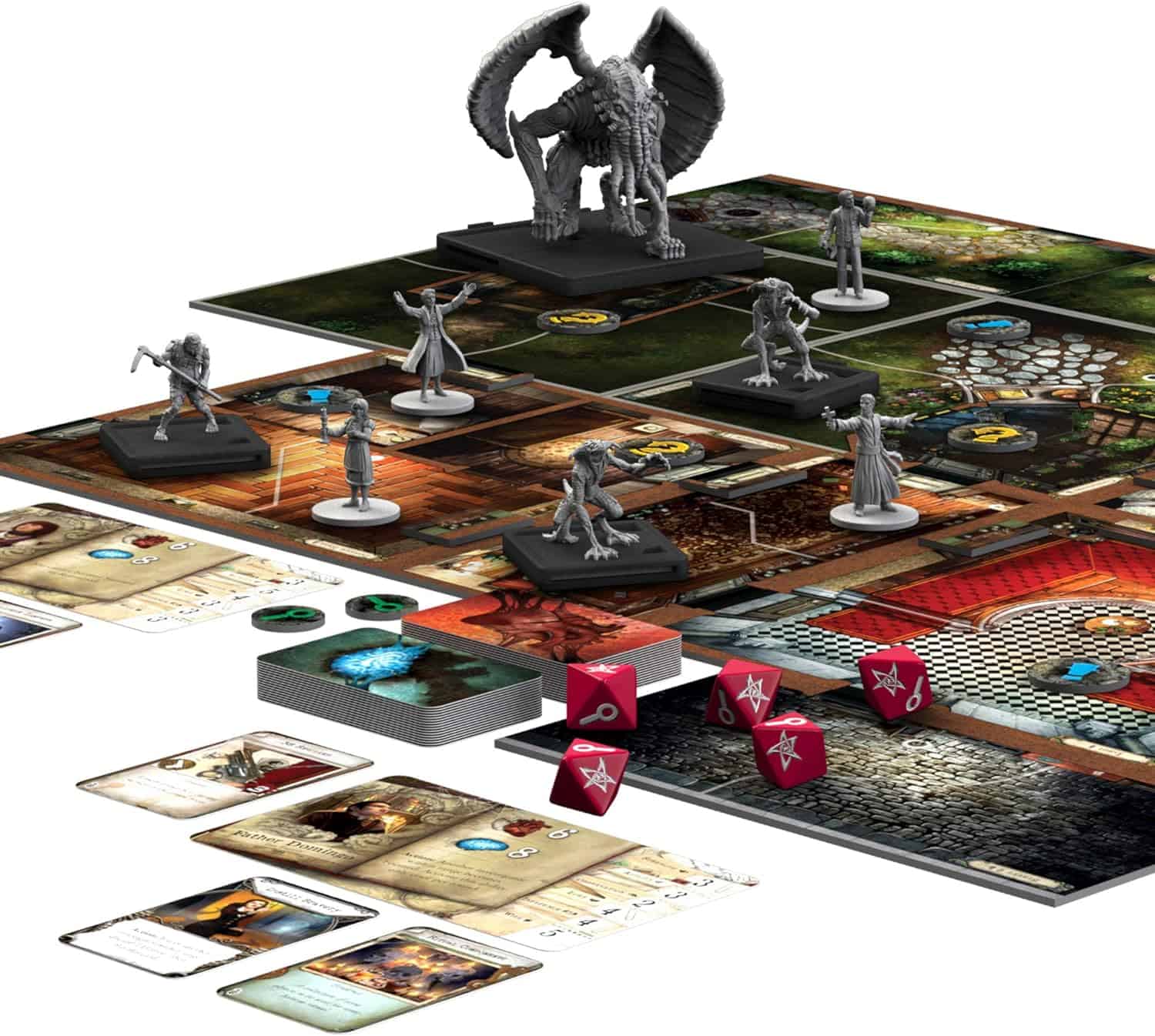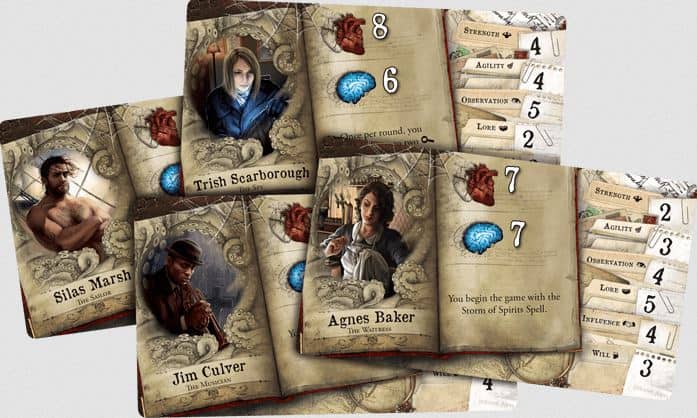My first experience of Mansions of Madness was as an investigator player – and boy was it a memorable one.
As I stepped across the threshold of the ominous Arkham mansion, a shiver ran down my spine. The air was thick with an oppressive sense of foreboding, and the flickering candlelight cast eerie shadows that seemed to dance with malevolence. Mansions of Madness was not just a game; it was a descent into the depths of terror and the unknown.
With every carefully chosen action, I felt the weight of my character’s fear and desperation. Puzzles and mysteries unfolded before me, each more cryptic and unsettling than the last.
The line between reality and nightmare blurred as I faced unspeakable horrors, their grotesque forms and insidious intentions threatening my sanity. Mansions of Madness was an immersive journey into a nightmarish realm, where my wits and courage were the only weapons against the encroaching darkness.
It was a game that left me with a lingering sense of unease long after I had returned to the safety of reality, a testament to the Keeper of that game in painting a vivid Lovecraftian landscape capable of evoking the most primal of fears. If you are a big fan of Lovecraftian or horror stories, I would highly recommend that you give this game a try.
What’s included in Mansions of Madness?

- Game Board: The modular game board represents the mansion, with different rooms, hallways, and outdoor areas.
- Investigator Figures: Each player selects an investigator character, represented by a miniature figure.
- Monster Figures: These represent the various horrors that inhabit the mansion.
- Tokens: Includes a variety of tokens, such as item tokens, search tokens, and more.
- Dice: You’ll need six-sided dice for various actions.
- Puzzle Pieces: For certain puzzles and scenarios.
- Investigator Cards: Each player receives an investigator card, which includes information about their character’s abilities and starting items.
- Keeper Cards: These cards are used by the Keeper (the player controlling the game’s narrative and the monsters) to manage the game’s events and challenges.
- Scenario Book: Contains the story, objectives, and instructions for the chosen scenario.
How to play Mansions of Madness?

Mansions of Madness is a cooperative board game set in the Lovecraftian horror universe, much like Arkham Horror, but with the presence of the Keeper player who guides the other players through the narrative of the game itself. Mansion of Madness combines elements of exploration, puzzle-solving, and tactical combat. Here’s a detailed guide on how to play:
Setup
- Choose a Scenario: Select a scenario from the scenario book and follow its setup instructions. Each scenario offers a unique story and set of objectives.
- Build the Mansion: Assemble the modular game board following the layout provided in the scenario.
- Choose Investigators: Players select investigator characters and receive their corresponding miniatures, cards, and starting items.
- Set Up Monster Figures: Place monster figures in their designated starting locations as indicated by the scenario.
- Prepare Tokens and Cards: Arrange item tokens, search tokens, and other components according to the scenario’s instructions.
- Establish Threat Level: The Keeper sets the threat level based on the scenario.
- Begin the Game: The game begins with the Keeper reading the introduction and story for the chosen scenario.
Rules for Mansion of Madness
Mansions of Madness is played in a series of rounds, with each round comprising the following phases:
- Keeper Phase: The Keeper takes the first turn in each round. They perform actions, such as moving monsters, revealing clues, and triggering events, to hinder the investigators.
- Investigator Phase: Investigators take turns in clockwise order. Each investigator has two actions they can perform, such as moving, searching, attacking monsters, and interacting with objects. Investigators can also share items with each other.
- Horror Check: Investigators may need to make horror checks when encountering terrifying situations or monsters. These checks test their sanity and can result in stress, injury, or madness.
- End of Round: After all investigators have taken their turns, the round ends. The game proceeds to the next round, starting with the Keeper Phase.
Winning and Losing: The outcome of “Mansions of Madness” depends on the scenario’s objectives. Investigators win by achieving the scenario’s goals, while the Keeper wins by preventing the investigators from succeeding. The game can also end if investigators are defeated or driven to madness.
Keeper Abilities and Actions: The Keeper uses Keeper cards to trigger events, control monsters, and create challenges for the investigators. These cards provide narrative context and introduce elements of surprise and tension.
Investigators to choose from in the game

Carson Sinclair: Once per round, you can perform a puzzle step or a trading step as a free action while on your space or an adjacent space.
Dexter Drake: When you perform a move action, you can discard a Clue card to move 1 additional space.
Joe Diamond: Once per round, you can reroll 1 die when resolving a puzzle.
Mandy Thompson: Once per round, when you gain 1 or more Clue cards from a Common item, Spell, or condition, draw 1 additional Clue card and then choose 1 Clue card to keep.
Ashcan Pete: Once per round, when you gain 1 or more Money from a Common item, Spell, or condition, draw 1 additional Money and then choose 1 Money to keep.
Jenny Barnes: Once per round, you can perform a trade action as a free action with another investigator on your space or an adjacent space.
Vincent Lee: Once per round, when you gain 1 or more Sanity from a Common item, Spell, or condition, draw 1 additional Sanity and then choose 1 Sanity to keep.
Michael McGlen: Once per round, when you gain 1 or more Health from a Common item, Spell, or condition, draw 1 additional Health and then choose 1 Health to keep.
Gloria Goldberg: Once per round, you can perform a search action as a free action while on your space or an adjacent space.
For the official rules, see the link below:
Strategies to improve the narrative experience
Investigator Strategies
- Collaboration is Key: Communication and teamwork are vital. Share information, coordinate actions, and leverage each investigator’s unique abilities to achieve your objectives.
- Prioritize Objectives: Focus on completing scenario objectives early. These objectives often provide crucial information and tools necessary for your survival and progress.
- Manage Your Actions: Be mindful of your actions. Investigate efficiently, but don’t rush. Carefully consider when to move, search, or attack. Avoid unnecessary combat if possible.
- Inventory Management: Keep track of your items and use them wisely. Certain items might be essential for solving puzzles or dealing with specific threats.
- Horror Checks: When making horror checks, consider the consequences. Sometimes, it’s better to accept stress or injury rather than risk madness. Collaborate with others to provide support during these checks.
- Clue Gathering: Investigate thoroughly. Search for clues, examine objects, and interact with NPCs (non-player characters) to gather information. Clues are often the key to progressing in the scenario.
- Stay Cautious: Be prepared for unexpected events and threats. As you explore, remain vigilant, and don’t be overly reckless. The mansion holds many surprises.
Keeper Strategies
- Storytelling: Embrace the role of the Keeper as a storyteller. Create an atmosphere of suspense and horror through your narration and Keeper cards. Engage players with the narrative.
- Balancing Challenge: While it’s your role to hinder the investigators, avoid making the game overly difficult. Striking a balance between challenge and enjoyment is crucial to keeping players engaged.
- Tactical Placement: Position monsters strategically. Try to cut off escape routes, block access to key locations, or use monsters to guard important items or clues.
- Resource Management: Manage your threat tokens wisely. Consider when to use them for special actions, such as spawning monsters or triggering events. Don’t exhaust your resources too early.
- Psychological Pressure: Use psychological tactics to increase tension. Hint at the unknown, create a sense of dread, and introduce unexpected twists to keep players on edge.
- Timing: Timing is essential when introducing critical events or threats. Sometimes, holding back and allowing investigators to explore before springing surprises can be more effective.
- Adapt to Investigator Actions: Be flexible and adapt to the choices and actions of the investigators. If they’re progressing rapidly, consider introducing obstacles to challenge them. If they’re struggling, provide opportunities for them to recover.
- Story Impact: Keep in mind the story’s impact on the investigators’ experience. While you want to challenge them, the narrative and the feeling of being part of a horror story should take precedence.